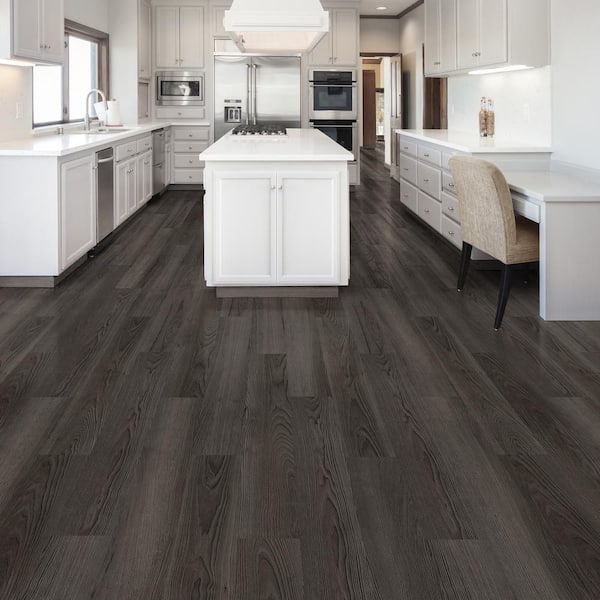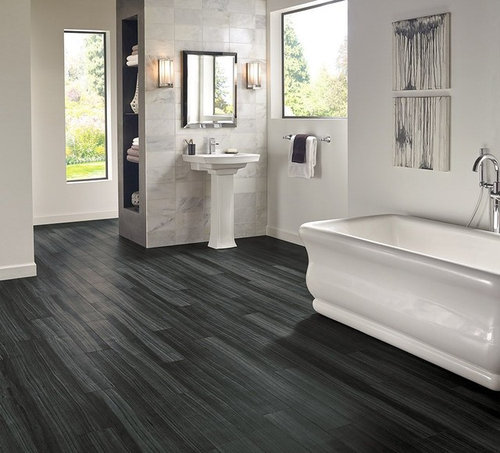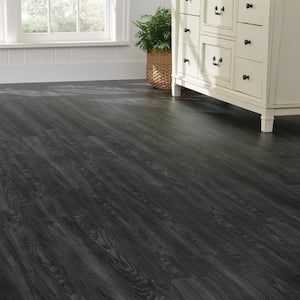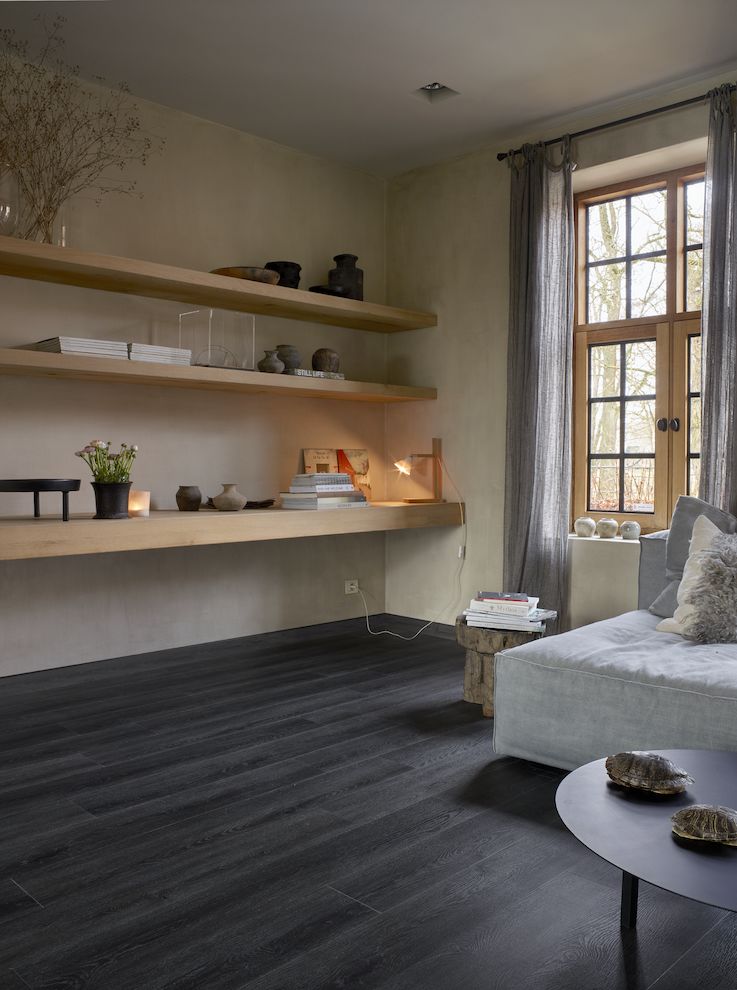Introduction to Black Wood Vinyl Flooring
Choosing the right flooring for your home can feel overwhelming, especially with so many options to consider. However, black wood vinyl flooring has become a popular choice among homeowners and interior designers. It perfectly combines dark-stained wood’s sophistication with vinyl’s practical advantages. Let’s find out what makes black wood vinyl flooring unique and why it’s capturing the attention of so many people.
- What Is Black Wood Vinyl Flooring?
Black wood vinyl flooring is a type of synthetic flooring designed to mimic the look of black-stained hardwood. It’s constructed with multiple layers, typically including a durable PVC backing, a photographic layer that resembles real wood, and a tough wear layer to protect against scratches and stains. This layered design makes it both attractive and functional, appealing to those who want the look of real wood but need a more budget-friendly and resilient option. - Why It’s Gaining Popularity
One reason black wood vinyl flooring is becoming so popular is its ability to deliver the aesthetics of high-end wood floors without the associated cost or maintenance. It’s ideal for people like me who love the elegance of dark wood but don’t want to worry about refinishing, warping, or excessive wear and tear. It’s a perfect mix of beauty and practicality that resonates with modern homeowners. - Versatility in Design
Whether your style is ultra-modern, farmhouse chic, or anything in between, black wood vinyl flooring can adapt to your vision. It comes in a variety of plank widths and lengths, as well as different textures and finishes, from matte to high gloss. This customization makes it easy to find a version that matches your decor, providing a seamless look throughout your home. For example, a textured finish can add a rustic feel, while a smooth, glossy surface offers a contemporary edge. - Durability for Busy Households
The strength and durability of black wood vinyl flooring are another reason it’s so appealing. It stands up well to high traffic, making it suitable for families with kids and pets. Thanks to its scratch-resistant wear layer, you won’t have to worry about your flooring getting damaged by everyday activities. In my own experience, this makes it an excellent option for areas like the living room or hallway, where durability is a top concern. - A Water-Resistant Option
One of the standout features of black wood vinyl flooring is its water resistance. Many brands even offer fully waterproof options, which makes it a fantastic choice for moisture-prone areas like kitchens, bathrooms, and basements. Unlike real wood, which can warp or stain when exposed to water, vinyl is designed to handle spills and humidity. This water resistance gives homeowners like us peace of mind, knowing our floors will stay in great shape even in less-than-ideal conditions. - Cost-Effective Yet Luxurious
Finally, black wood vinyl flooring is surprisingly affordable compared to hardwood, especially when you consider the long-term benefits. While hardwood can cost a small fortune and require ongoing maintenance, vinyl offers a similar look for a fraction of the price. And because it’s easy to clean and doesn’t require refinishing, you’ll save both time and money over the years. For budget-conscious homeowners, it’s a luxurious option that doesn’t drain your wallet.

Key Benefits of Choosing Black Wood Vinyl
With so many flooring options available, it’s important to weigh the benefits of each before making a decision. Black wood vinyl flooring brings a host of advantages that make it a fantastic investment for various spaces. From its durability to its stunning aesthetics, let’s explore the key benefits of this stylish flooring option.
Incredibly Durable and Long-Lasting
One of the biggest perks of black wood vinyl flooring is its impressive durability. Its layered construction means it can withstand heavy foot traffic, making it perfect for busy households. Unlike real wood, vinyl is less likely to scratch, dent, or fade over time. For those of us who have kids, or pets, or simply want a low-maintenance option, this flooring can handle the hustle and bustle of everyday life.
Water and Stain Resistant
Another major advantage is its resistance to water and stains. Whether you spill a drink in the kitchen or your bathroom has high humidity, black wood vinyl flooring holds up under pressure. Many versions are designed to be fully waterproof, which means you don’t have to worry about warping or water damage. This feature gives you the freedom to install it in any room without fear of ruining your floors.
Easy to Maintain
When it comes to maintenance, black wood vinyl flooring is a dream come true. A simple sweep or mop is all you need to keep it looking clean and fresh. Since it doesn’t require refinishing like hardwood, it saves you time and effort in the long run. This convenience is especially valuable for those of us with busy schedules who still want our homes to look polished and well-kept.
Budget-Friendly Without Sacrificing Style
Cost is always a factor when choosing flooring, and black wood vinyl delivers luxury at an affordable price. It provides the high-end look of dark-stained wood without the hefty price tag. Plus, the cost of installation is often lower compared to hardwood, making it a cost-effective solution for large spaces. If you want to achieve a stunning, elegant look on a budget, this flooring is an excellent choice.
Comfort Underfoot
Unlike ceramic tiles or hardwood, vinyl flooring offers a softer and more comfortable feel underfoot. It has a bit of flexibility, which makes walking on it more pleasant, especially in areas where you stand for long periods, like the kitchen. Some varieties even come with an underlayment that provides additional cushioning and sound absorption, making your home quieter and more comfortable.
Eco-Friendly Options Available
If sustainability is important to you, you’ll be happy to know that some manufacturers offer eco-friendly black wood vinyl flooring. These versions are made from recycled materials and are 100% recyclable at the end of their life cycle. Choosing these options allows you to enjoy the beauty and benefits of vinyl while also being kind to the planet.
Comparing Black Wood Vinyl to Other Flooring Options
When you’re trying to decide on new flooring, it helps to compare different materials to see what best suits your lifestyle. Black wood vinyl stands out in a crowded market, but how does it measure up against options like hardwood, laminate, or tile? Here’s a breakdown of how black wood vinyl compares to these popular alternatives.
Black Wood Vinyl vs. Hardwood
Hardwood floors are a classic choice known for their natural beauty, but they come with their fair share of challenges. They’re expensive, prone to scratches, and can be easily damaged by moisture. Black wood vinyl flooring, on the other hand, provides a similar look without these drawbacks. It’s more durable, easier to maintain, and significantly cheaper. For me, the trade-off is well worth it, especially if you want the wood aesthetic without the hassle.
Black Wood Vinyl vs. Laminate
Laminate is another budget-friendly option that mimics the look of wood, but it doesn’t quite measure up to vinyl in terms of moisture resistance. While laminate can swell and warp when exposed to water, vinyl handles moisture much better, making it a superior choice for bathrooms, kitchens, or basements. Both are easy to install, but vinyl’s edge in durability and water resistance makes it the more versatile option.
Black Wood Vinyl vs. Tile
Tile is a durable and water-resistant option that’s commonly used in bathrooms and kitchens. However, it tends to be cold and hard underfoot, which can be uncomfortable in living areas or bedrooms. Black wood vinyl provides a warmer, softer feel while still offering excellent water resistance. For those of us who prefer a cozier atmosphere, vinyl is a fantastic alternative to the harshness of tile.
Black Wood Vinyl vs. Carpet
Carpet is known for its comfort and warmth, but it’s not ideal for every space. It stains easily, holds onto allergens, and requires frequent cleaning. Black wood vinyl, in contrast, is hypoallergenic and simple to clean. It provides a modern, stylish look that carpet can’t compete with, especially in high-traffic or spill-prone areas. I find vinyl to be a more practical and hygienic choice for most homes.
Ease of Installation Across Options
When comparing ease of installation, black wood vinyl often comes out on top. It can be installed as a floating floor, which doesn’t require nails or glue, making it a popular DIY project. In contrast, hardwood and tile usually need professional installation, which adds to the cost and complexity. Laminate and vinyl are similar in their DIY-friendliness, but vinyl’s flexibility makes it easier to work with in tricky areas.
Overall Value for Money
Taking into account cost, durability, and maintenance, black wood vinyl flooring offers outstanding value for money. It provides the luxurious appearance of high-end materials without their downsides. If you’re looking for a cost-effective solution that doesn’t compromise on style or performance, vinyl stands out as a clear winner.
Installation Tips for Black Wood Vinyl Flooring
Installing black wood vinyl flooring might seem intimidating at first, but with the right preparation and tools, it can be a straightforward process. Whether you’re a seasoned DIY enthusiast or a first-time installer, these tips will help you achieve professional-looking results and ensure your new floors last for years to come.
Start with a Clean, Level Subfloor
The first step to a successful installation is preparing your subfloor. Make sure it’s clean, dry, and level before you lay down any vinyl planks. Even minor imperfections can cause issues, so patch up any holes or cracks and sand down high spots. Trust me, spending extra time on this step is worth it to prevent future problems like uneven planks or gaps.
Acclimate Your Flooring
Before installation, let your black wood vinyl flooring acclimate to the room’s temperature and humidity for at least 48 hours. This step is crucial because vinyl can expand or contract based on the environment. By acclimating the planks, you minimize the risk of warping after installation. I always recommend this step, even if the manufacturer claims it’s unnecessary.
Plan Your Layout Carefully
Take some time to plan the layout of your planks before you start cutting or gluing. Lay out a few rows to get a sense of how they’ll look and adjust the layout to minimize small or uneven cuts at the edges. If you’re like me and prefer a more natural look, consider staggering the planks so that the seams don’t align too evenly. This will give the floor a more authentic, wood-like appearance.
Use the Right Tools and Adhesives
Depending on whether you’re doing a glue-down, peel-and-stick, or click-lock installation, you’ll need different tools and materials. For a floating floor, a rubber mallet and tapping block will help lock the planks together without damaging them. For glue-down installations, use a high-quality adhesive that’s recommended for vinyl. Always follow the manufacturer’s guidelines to ensure the best results.
Leave Room for Expansion
Vinyl expands and contracts with temperature changes, so it’s important to leave a small gap (usually around 1/4 inch) between the flooring and the walls. Use spacers to maintain this gap, which will later be covered by baseboards or trim. It may seem like a small detail, but it makes a big difference in the floor’s performance over time.
Finish with Care
Once all the planks are installed, take your time with the finishing touches. Remove any spacers and install your baseboards or molding to cover the expansion gaps. If you need to cut around obstacles like door frames, use a jigsaw for clean, precise cuts. Finally, give your new floor a gentle cleaning to remove any dust or debris from the installation process. You’ll be amazed at how polished your space looks!
How to Maintain and Care for Your Black Wood Vinyl Floors
Black wood vinyl flooring is known for being low maintenance, but that doesn’t mean it’s completely maintenance-free. To keep your floors looking their best and to maximize their lifespan, it’s essential to follow a few simple care and cleaning guidelines. Here’s a rundown of how to maintain your blackwood vinyl flooring effectively.
Daily Cleaning Habits
To maintain the stunning look of your black wood vinyl floors, make a habit of sweeping or vacuuming regularly. Dirt and grit can act like sandpaper, scratching the surface of your flooring. I prefer using a soft-bristle broom or a vacuum without a beater bar to prevent damage. A quick daily sweep keeps the floors looking fresh and prevents long-term wear.
Mop with Care
When it comes to mopping, use a damp—not soaking wet—mop and a mild cleaner designed for vinyl flooring. Excess water can seep into the seams and cause the planks to lift or warp, so always wring out your mop well. For a natural cleaning solution, you can mix a bit of vinegar with warm water. It’s effective, eco-friendly, and keeps your floors looking spotless.
Avoid Harsh Chemicals
Steer clear of abrasive cleaners, bleach, or ammonia-based products, as they can damage the protective wear layer of your vinyl. Instead, opt for a pH-neutral cleaner specifically formulated for vinyl flooring. I always keep it simple and stick to products recommended by the manufacturer to ensure my floors stay in pristine condition.
Preventative Measures
Preventative care goes a long way in preserving the beauty of your blackwood vinyl flooring. Use area rugs or mats in high-traffic areas and places prone to spills, like under the kitchen sink. Felt pads on the bottom of furniture legs are a lifesaver, protecting the floor from scratches. And, if you have pets, keep their nails trimmed to minimize any potential damage.
Handle Stains and Spills Immediately
While vinyl is water-resistant, it’s best to clean up spills as soon as they happen. Use a soft cloth to blot, not rub, spills to avoid spreading the mess. For stubborn stains, a bit of baking soda paste can work wonders without damaging the flooring. Trust me, acting quickly will prevent stains from setting and keep your floors looking immaculate.
Routine Maintenance Checks
Finally, it’s a good idea to inspect your flooring periodically for any signs of wear or damage. Look for loose planks or lifting edges and address these issues promptly. In my experience, taking care of minor problems early on can prevent more significant repairs down the line. Plus, routine maintenance ensures your floors stay beautiful and functional for years to come.
Common Mistakes to Avoid
While black wood vinyl flooring is relatively easy to work with and maintain, there are some common pitfalls to be aware of. Avoiding these mistakes can save you time, money, and frustration. Here’s a list of things to watch out for when installing and caring for your vinyl floors.
Skipping Subfloor Preparation
One of the biggest mistakes you can make is neglecting to prepare your subfloor. Uneven or dirty subfloors can lead to issues like gaps, bumps, or even planks coming loose over time. Before installation, make sure your subfloor is clean, level, and dry. Trust me, it’s worth the extra effort to avoid costly repairs later.
Not Allowing for Expansion Gaps
Another common mistake is failing to leave enough room for the vinyl to expand and contract. Vinyl flooring needs space to accommodate temperature changes, so always leave a small gap around the edges of the room. Using spacers during installation helps maintain this gap, which can later be covered by baseboards or molding.
Using the Wrong Cleaning Products
Using harsh chemicals or abrasive tools on black wood vinyl flooring can damage the surface and dull the finish. Stick to gentle, pH-neutral cleaners and soft mops or cloths. I’ve learned from experience that shortcuts in cleaning can lead to long-term damage, so it’s best to use the right products from the start.
Dragging Furniture Across the Floor
Dragging heavy furniture can cause deep scratches or even tear the vinyl. Always lift furniture when moving it, and use furniture pads to protect your floor. If you’re rearranging your space, take the time to prevent damage—your floors will thank you for it.
Neglecting Preventative Care
Skipping simple preventative measures, like using rugs in high-traffic areas or placing mats at entryways, can lead to premature wear. Dirt and moisture are the enemies of vinyl flooring, so putting down rugs and mats is a simple way to extend the life of your floors. Preventative care is easy to implement and goes a long way.
Ignoring Manufacturer Guidelines
Finally, not following the manufacturer’s instructions for installation and maintenance is a recipe for disaster. Each vinyl product may have specific requirements, so read and adhere to the guidelines. I’ve found that taking the time to understand these instructions can make a huge difference in the longevity and appearance of your floors.
Black – Vinyl Plank Flooring – Vinyl Flooring
Pin on Karndean Vinyl
Inspiration – Vinyl Planks BerryAlloc®
Lamp Wood
Selkirk Vinyl Plank Flooring-Waterproof Click Lock Wood Grain-5.5
Related Posts:









